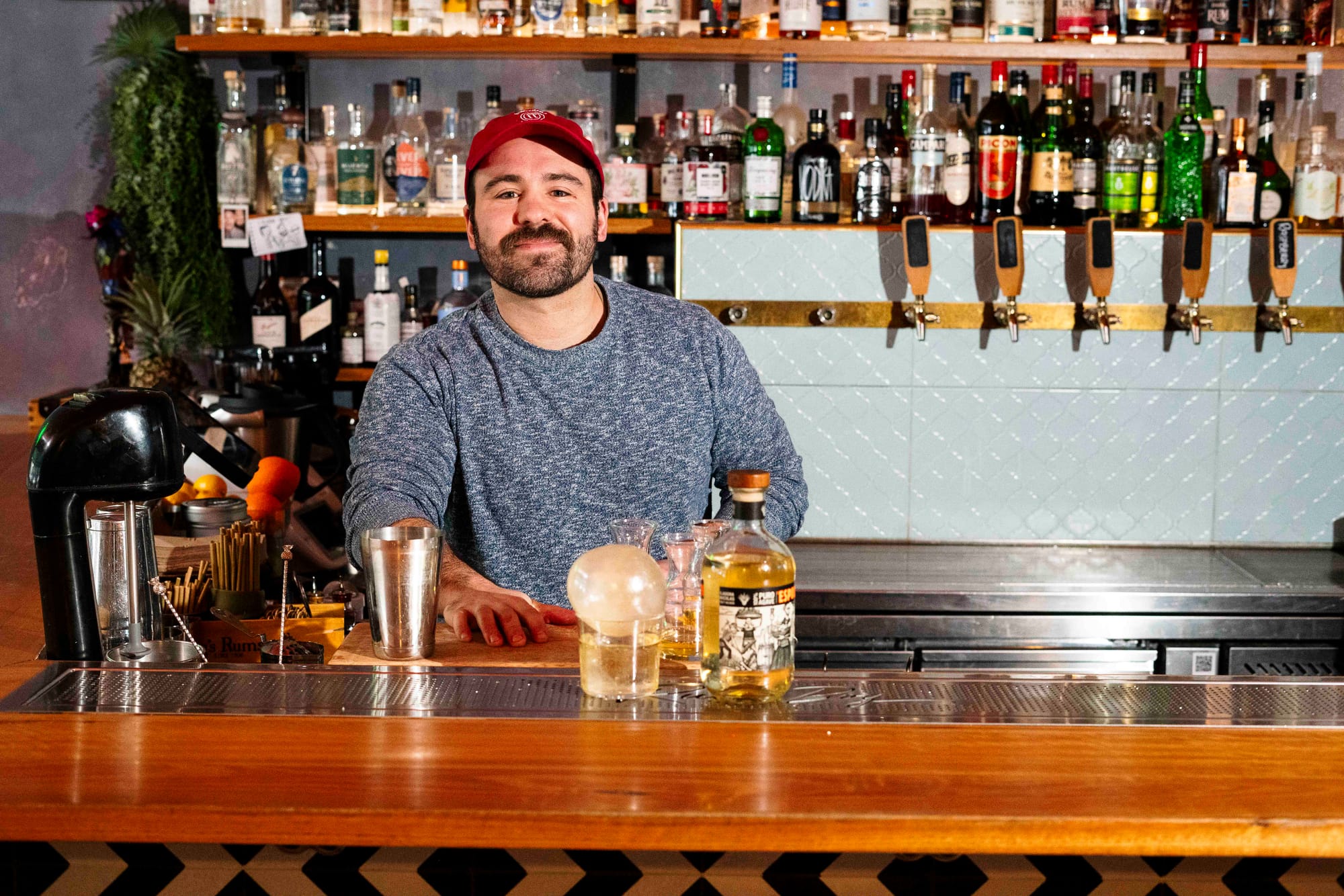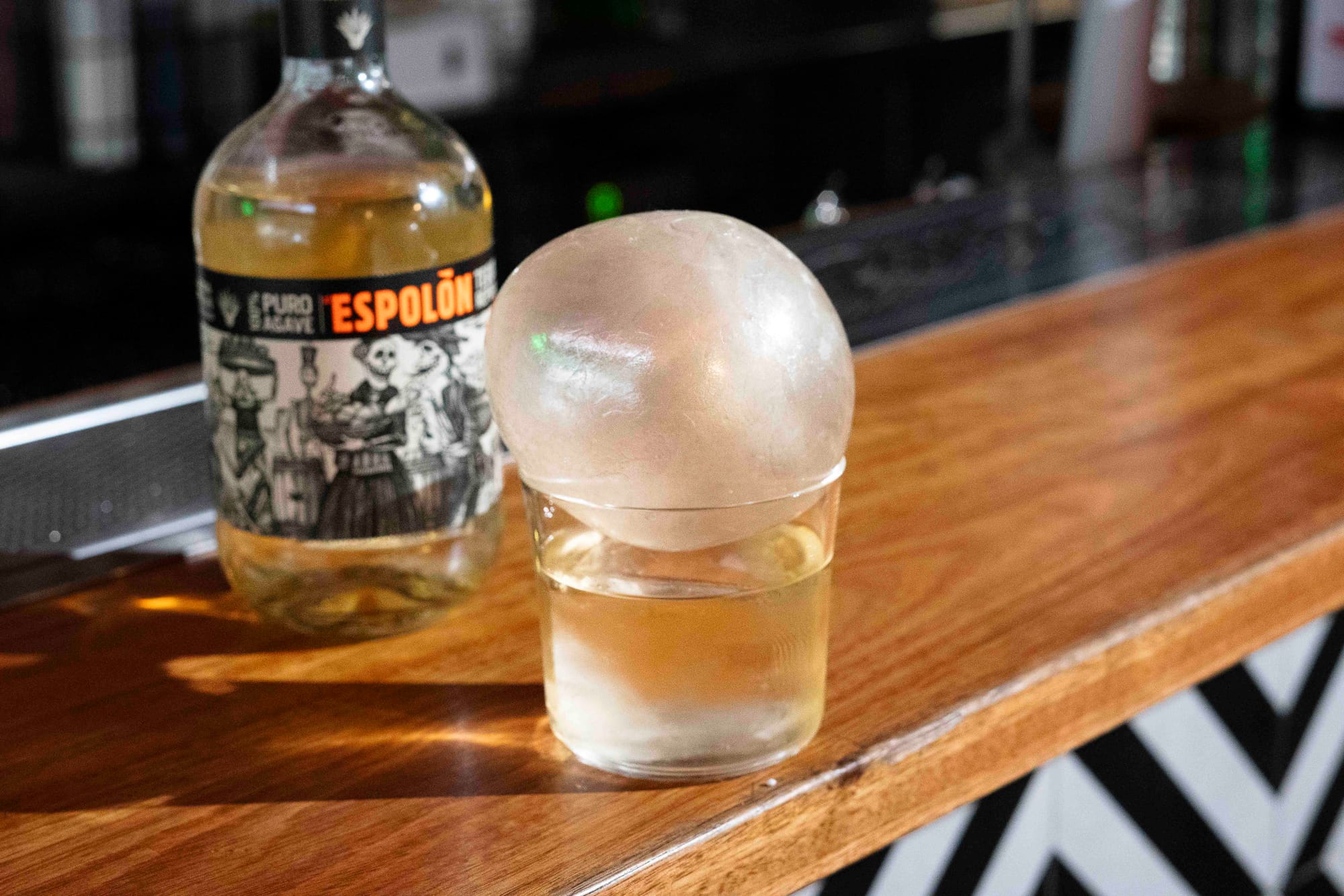
Four months ago, Jack Turner — along with Kayla and Rohan Massie, and Campbell Nicol — took ownership of bartender favourite, Rude Boy, in Hobart.
They’re known for their fried chicken — its deliciousness we can vouch for — as well as their cocktails. And Jack is one of the top 25 bartenders in the Espolòn Afterlife To The Bone cocktail competition.
That means that you can get a taste of his entry into the competition, called Gallo Feroz, at Rude Boy throughout August. And if Jack impresses the judges, he’ll be off to Sydney next month for the national final during Sydney Bar Week.
Below, lightly edited and condensed for clarity, Jack talks about his drink, about Rude Boy, and why it takes a village to create a great drink.
So you’re an owner — does that mean you do everything here?
100 percent. Like a true small business owner, helping renovate the place, getting everything sorted. You know, we’re part of such a great team with Kayla, Rowan and Campbell. Like the four of us really do everything we possibly can.
How long have you been here as an owner?
It’s been four months now. Tasmania winters, if anyone hasn’t come down here, they can be tough. Beyond Dark MoFo, which is such a great event which gets all these people down. The rest of winter can be pretty quiet. And you’ve got to really lean in on your locals and really lean in on your hospitality community. And you’ve got to be a bit generous to get a bit.
Tell us about your drink.
So the name of my drink is Gallo Feroz, which was taken from two inspirations. It was inspired by the Algonquin classic cocktail. Super, forgotten classic, but if you read through those books, you’re like, yeah, it’s around. People have seen it. It’s a good drink to work with.
Anyway, it is a rye drink, dry vermouth, pineapple juice and depending on which book you go through, a splash of sugar as well.
The Algonquin Hotel in New York, super famous, had a group of people that were notable figures, and they were called the Vicious Circle, which honestly it was smart and famous people just hanging out with smart and famous people collaborating about ideas. They would also play a lot of practical jokes.

Where do you get your drink ideas from?
When I’m trying to find cocktail ideas, I think the biggest thing that I hate seeing is everyone being like, it has to be these super meaningful, so close to your heart, personal things. Realistically, we all do the same thing. We get in the books, we get on the internet, we Google things, we try and find inspiration.
I think if people were more transparent and just said, this is the drink I want to make, this is why it connects. That’s a truer story than, and like the journey to get to why you did what you did is more interesting for me than this very loose, convoluted story.
I really wanted to lean in on that idea of collaborative effort. I took, just like any bartender, I pinched ideas off everyone else and put them together. And you know, there were some really, really cool bartenders like Cameron Atfield in London, he did the isomalt bubble thing for a garnish in say 2019. That was where the garnish came from.
I made a pineapple vinegar. I just wanted something that was gonna be a little bit more bright.
And then sage tied into the ceremony aspect of it, I went really straight down the line with my ritual, a smoking ceremony — globally they’re all over different communities, all that. I’m not getting caught up in one specific one. So I did a sage smoke filled isomalt bubble, which you’d crack over the glass and then that would dissipate. And that’s the idea of cleansing.
I took a little technique from Ian McPherson from Panda & Sons and did a switched apple vermouth. It’s a showcase of Tasmania and where we are, and that’s still important.
I’ve done Espolòn Reposado, which is really the star, so classically it was rye and I’ve used Reposado Tequila. You get a lot more of those really complex, funky agave notes coming through. There’s a little bit of green pepper that still comes through on this one, which I kinda like, which blends itself with my switched apple vermouth.
Switching is a pretty contemporary technique that a few people have really got behind, but it was an Ian McPherson thing, like I said, where you’re taking out the water content of a product and replacing it with something else at its most basic form.
And then I took a little Orlando Marzo technique, where he was doing reverse syrups, but it’s like a pastry technique of invert sugar syrups, I used sage because I wanted that and it’s a really really fragrant. It’s all about capturing aromas.
So it takes a village to create a cocktail?
Yeah, yeah, 100 percent. Everyone pulls inspiration from everyone. I think the great thing about it is, every single one of those people I’ve also messaged on social media, they’ve responded and taught me how to do it. Like I am not gonna take somebody’s idea without at least flicking a message or giving some sort of recognition for it.

Gallo Feroz
35ml Espolon Reposado
30ml Switched Apple Vermouth
5ml pineapple and cascara vinegar
2.5ml reverse sage syrup
1.25ml 6% lactic acid solution
1.25ml 10% soda bicarbonate solution
For the switched apple vermouth:
500ml cinzano dry vermouth
500ml clarified summer bliss apples
1. Freeze 500ml dry vermouth at -18 degrees celsius.
2. Juice apples with 0.2% pectinase.
3. Let apple juice rest for 1 hour.
4. Strain and reserve.
5. Remove dry vermouth from freezer after 24 hours.
6. Strain through chinois, the water should have formed a slushy like texture which we reserve and weigh.
7. Replace the water content for the concentrated dry vermouth with your clarified apple juice.
For the pineapple and cascara vinegar:
750ml organic apple cider vinegar
500g diced pineapple
15g cascara
3g salt
170g sugar
Add all together in a vac bag. Vacuum seal and let rest for 72 hours. Strain and reserve. Let rest for 72 hours. Rack and bottle.
For the reverse sage syrup:
200g white caster sugar
100g water
25g sage
1.5g tartaric acid
Heat sugar and water to 110 degrees, pour into a wide flat tray. Add sage. Store in fridge overnight. Strain and reserve.
For the lactic acid solution:
94g water
6g lactic acid powder
Blend and reserve.
10% soda bicarbonate
90g water
10g soda bicarb
Blend and reserve.
For the pineapple and sage isomalt bubble:
200g isomalt
20g Marionette pineapple liqueur
Heat isomalt to 180 degrees. Pour onto silpad. Fold using silpad to create a clay. Pull the clay to introduce oxygen and keep your bubble light. Insert your pipe to blow into the clay bubble 1/3 of the way in. Slowly introduce oxygen until the appropriate size. Use a heat lamp to adjust, and leave a hole for your smoke gun.
For the sage dust:
10g sage, microwave for 2 minutes in 30 second burst. Add to spice grinder, blitz and dust your isomalt bubble while still warm.
For the sage smoke:
Take 10g sage, dehydrate sage using microwave. Compact using vacuum pac, add to smoke gun, add the smoke directly to the bubble.










